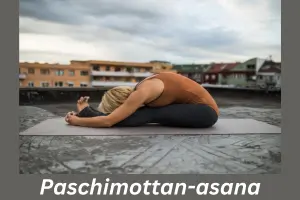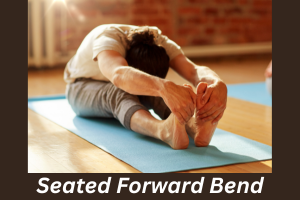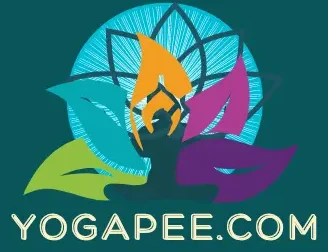Introduction
Paschimottanasana or the Seated Forward Bend, is a classic yoga pose known for its deep stretch and calming effects.
Derived from the Sanskrit words “Paschima” meaning “west” or “back” and “Uttana” meaning “intense stretch,”


This pose targets the back of the body, especially the spine, hamstrings, and lower back.
It’s often used to enhance flexibility, stimulate digestion, and promote relaxation by encouraging a gentle forward fold that quiets the mind and stretches the body.
Steps to Perform Paschimottanasana Yoga Pose ( Seated Forward Bend)
- Begin by sitting on the floor with your legs extended straight in front of you, feet together, and spine erect.
- Inhale deeply, lifting your arms overhead to lengthen your spine.
- As you exhale, hinge at your hips and slowly fold forward, reaching toward your feet.
- Keep your back straight and avoid rounding your spine. If your hands can’t reach your feet, hold your ankles, shins, or knees.
- Hold the pose, focusing on deep breaths, and gradually deepen the stretch with each exhale.
- Stay in the pose for 30 seconds to 1 minute, then gently release by inhaling and lifting your torso back up.
Benefits of Paschimottanasana Yoga Pose ( Seated Forward Bend)
- Improves Flexibility: This pose provides an excellent stretch for the hamstrings, lower back, and spine, improving flexibility over time.
- Stimulates Digestion: The forward fold gently massages the abdominal organs, aiding in digestion and relieving bloating or constipation.
- Calms the Mind: Paschimottanasana has a calming effect on the nervous system, reducing anxiety, stress, and mental fatigue.
- Eases Lower Back Pain: By stretching and strengthening the lower back, this pose can relieve mild lower back pain and stiffness.
- Enhances Circulation: The stretch encourages blood flow throughout the body, improving circulation to the spine and internal organs.
Precautions and Contraindications for Paschimottanasana Yoga Pose ( Seated Forward Bend)
- Back or Spine Injuries: Avoid deep forward bends if you have existing back issues, spinal disc problems, or recent injuries. Use props such as a bolster for support.
- Tight Hamstrings: If you have tight hamstrings, avoid forcing the stretch. Use a strap or bend your knees slightly to protect your lower back.
- Pregnancy: Pregnant individuals should avoid this pose, as the deep forward bend may compress the belly. Instead, opt for modified seated stretches.
- Asthma or Respiratory Issues: If you have difficulty breathing, move into this pose gradually, focusing on maintaining steady, even breaths.
Conclusion
- Paschimottanasana is a versatile and accessible pose that offers both physical and mental benefits.
- Regular practice helps improve flexibility, stimulate digestion, and promote mental calmness.
- However, it’s essential to approach this pose mindfully, respecting your body’s limits to avoid strain or injury.
- Whether you’re a beginner or experienced practitioner, This Pose is a valuable addition to any yoga routine, enhancing overall well-being and promoting a deep sense of relaxation.
- Seated Forward Bend, is a powerful yoga pose that brings together both physical and mental benefits.
- Its ability to deeply stretch the back body, especially the hamstrings, spine, and lower back, makes it an excellent posture for increasing flexibility and relieving muscle tension.
- The pose’s forward-folding nature helps calm the nervous system, promoting mental clarity and reducing stress.
- By focusing on deep breathing while in the pose, practitioners can experience a sense of grounding and relaxation, making it a great addition to any routine aimed at mindfulness and stress relief.
- Paschimottanasana is also known to stimulate the digestive organs, improving digestion and relieving constipation.
- It enhances circulation and blood flow to vital organs, helping to detoxify the body.
- However, like any yoga pose, it should be practiced with caution, particularly by individuals with back injuries or hamstring tightness.
- Modifications can be made using props like straps or bolsters to make the pose accessible to all levels.
